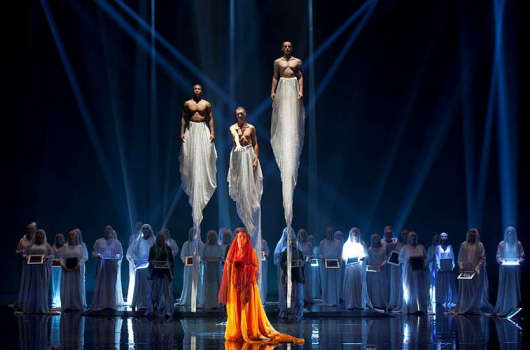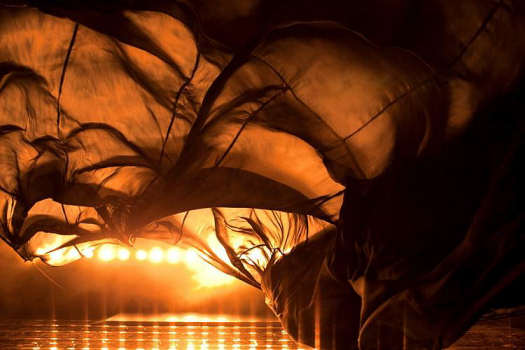Other Links
Editorial Board
-
Editor - Bill Kenny
-
Deputy Editor - Bob Briggs
Founder - Len Mullenger
Google Site Search
SEEN AND HEARD UK OPERA REVIEW
Kaija Saariaho, L’amour de loin: (New Production Premiere) Soloists, Chorus and Orchestra of English National Opera/Edward Gardner. London Coliseum, 3.7. 2009 (CC)
Jaufré Rudel: Roderick Williams (baritone)
Spirits of Jaufré: Antoine Marc, Ted Sikström
Clémence: Joan Rodgers (soprano)
Spirit of Clémence: Sara Lundstedt, Lili Mühleisen
Pilgrim: Faith Sherman (mezzo)
Spirit of Pilgrim: Tamzen Moulding, Phillipa Anderson
Shadow Theatre Actors: Robyn Simpson, Jami Reid-Quarrell

Joan Rodgers (Clémence)
and the Spirits of
Jaufré
Kaija Saariaho’s first opera L’amour de loin (“Love from afar”) was premiered at the 2000 Salzburg Festival, where it was presented in collaboration with the Théâtre du Châtelet, Paris and Santa Fe Opera. Saariaho collaborated with another Paris-based artist, the Lebanese-French writer Amin Maalouf (originally, the librettist was to have been the poet Jacques Roubaud) for this tale of what might be described as “medieval internet dating”. Much of the work’s dynamic is determined by the protagonists’ feelings about meeting for the first time; the internet dating analogy is actually suggested in the ENO podcast that accompanies these performances.
Saariaho was inspired to create an opera (something she had always backed away from) by experiencing Messiaen’s Saint François d’Assise at the Salzburg Festival in 1992. In addition to being influenced by the static, tableaux-like nature of Messiaen’s score, there are resonances in her piece with Wagner’s Tristan und Isolde (the idea of the lover arriving, only to expire shortly thereafter) and the shadowy world of Debussy’s Pelléas et Mélisande (in fact there is one passage towards the end of the second act that decidedly suggests Debussy’s masterpiece). The use of several people for one character in this production is reminiscent of Birtwistle’s Mask of Orpheus, another piece that revisits myth. Saariaho uses dance effectively (here six expert acrobats, two per singer, who act out the story as the singers’ spirits), with the dancers sometimes commenting, sometimes acting out internal emotions of the character they are associated with.

The plot is simple. Jaufré Rudel, a troubadour and Prince of Blaye, is dissatisfied with his lot. He focuses on a seemingly unattainable dream, of a love in a distant land. A Pilgrim tells him that this love does indeed exist. This Pilgrim acts as a intermediary between the two main protagonists, and she tells Clémence (Countess of Tripoli) of Jaufré’s existence. Saariaho and Maalouf explore the emotional reactions of Clémence and Jaufré to their predicament (is it best for the “lover” to remain idealised?). Jaufré sets off to find his love but falls ill en route because of his anguish; the two finally meet, but it is too late. After Jaufré’s death, Clémence decides to take the veil; the work ends with Clémence’s prayer, a great moment for the singer involved.
This was the UK staged premiere of the work (the actual UK premiere took place at the Barbican in a concert performance in 2002). English National Opera has made the decision to offer all seats at £20, in a bid to fill the theatre – a bid that seemed to work, as this looked to be a nearly-full house (with the majority, if not everyone, returning after the interval).
Saariaho’s sound-world is lush, almost post-Impressionist and often heard as if through a veil. ENO’s orchestra was on top form, possibly galvanised into such excellence by Gardner, possibly by the composer’s presence, most likely by a combination of the two. In particular there was some stunning string playing (high, sustained harmonics that were beautifully maintained). The excellence of the orchestral standard was mirrored by that of the production. Colour was used with a simplicity that seemed to emphasise the bare-bone plot while accurately reflecting the emotions of the particular scene. Is the Director/Lighting Designer/Choeographer Daniele Finzi Pasca synaesthesic I wonder? Some effects were jaw-dropping – the billowing sheet that became the sea shimmying in over the audience’s heads, for example. Finzi Pasca’s direction ensures that the elusive mature of Saariaho’s musical surface is fully reflected in what we see on-stage. Shadow-play, in particular, is used effectively.
Saariaho uses different musical means for each character: Clémence is given a predominance of seconds and thirds; the Pilgrim is associated with a rapidly descending motif; Jaufré has the wider intervals of a fourth and a fifth as his melodic basis.
Roderick Williams is a very experienced singer whose focussed voice made the most of Saariaho’s long, lyric lines; occasionally one wondered, though, if he was on very top form. In fact it was Joan Rodgers who stole the show, her voice immediately recognisable. Her cries of “Troubadour” were truly memorable, her long song towards the end of Act II (enhanced by choral commentary) was magnificent. It was in the final scene of the opera, though, that she towered, her plea to God superb, her final dedication of herself to her deity absolutely believable.
It is interesting that in the Salzburg World Premiere, the part of the Pilgrim was taken by the astonishing Dagmar Pecková. Pecková’s voice can be infinitely dark and would surely have been perfect for this ambiguous role – for the Pilgrim, not only seems more than attached to Clémence, but seems attracted to Jaufré, also. Her role is not just that of intermediary – implicitly, she becomes more than that. Here, the part was taken by the American mezzo Faith Sherman, making her European debut in this role. She was actually excellent, acting and singing superbly and with good stage presence.
The pace of the action is ultra-slow (the friend that accompanied me suggested in the interval that Jaufré and Clémence “need a good slap”). The well-trained chorus acts as a kind of commentator, a Greek chorus perhaps, in keeping with the meditative aspects of the score. But slow is not necessarily bad, and neither is it boring, certainly not in the hands of Saariaho.
Although there is a Nagano recording (it was he who conducted the premiere), this piece really should be seen as well as heard, so the recommendation if you would like to follow this up is the 2005 Peter Sellars DVD, conducted by Salonen, with Dawn Upshaw, Gerald Finley and Monica Groop in the principal roles. If you just want to experiment with the sound-world of the opera, there is a single Ondine disc that features the Cinq Reflets de “L’amour de loin” (ODE1049-2).
Colin Clarke
Pictures © Johan Persson
